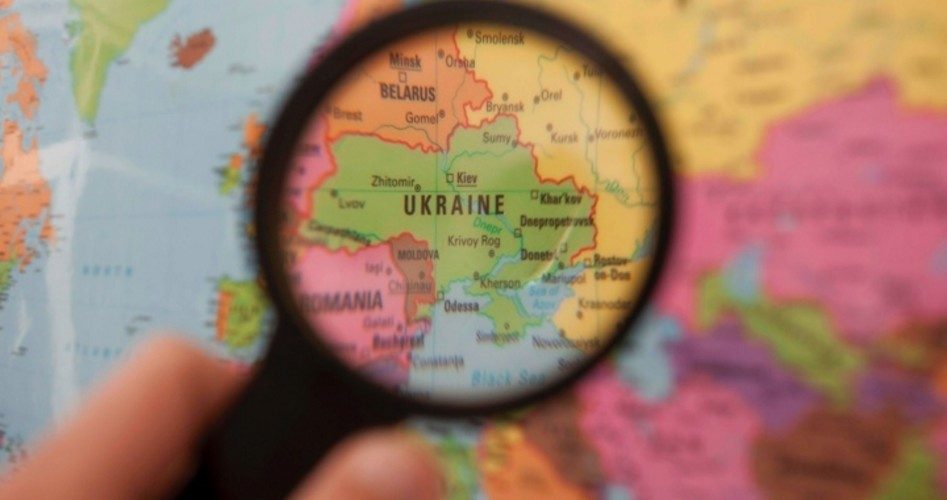
Russian officials denounced the anticipated arrival of U.S. troops for a training mission in Ukraine a “provocation” that could result in serious consequences for “Kiev authorities and the Ukrainian people.” The training exercise, first announced last August, was scheduled to begin this month. Colonel Michael Foster of the 173rd Airborne Brigade, based in Vincenza, Italy, announced last Monday that the United States would be sending just under a battalion of soldiers to Ukraine to train troops from the Ukrainian National Guard by the end of the week. But on Friday a spokesman for U.S. forces in Europe told the Reuters news service that the training mission had been on hold indefinitely while a ceasefire agreement, reached in Minsk last month between the Ukraine government and rebel forces, remains in place.
“The U.S. government would like to see the Minsk agreement fulfilled,” according to a statement issued by U.S. Army Europe. “The training mission is currently on hold but Army Europe is prepared to carry out the mission if and when our government decides to move forward,” the statement said.
The announcement came along with news last week that U.S. military exercises with Poland, Estonia, Latvia, and Lithuania, which began last April, will expand through the coming summer, with the U.S. planning to send troops to Romania and Bulgaria and possibly Hungary, the Czech Republic, and Georgia, Russia’s southern neighbor.
New agreements with former Soviet satellite nations lay the groundwork for U.S. Air Force training missions in “countries such as Bulgaria, Romania and Estonia,” according to the Air Force Times. The missions will include the use F-15 and F-16 airlift aircraft, along with the A-10 fighter plane, to “show the military’s force in the region,” the Air Force Times reported.
Lieutenant General Ben Hodges, the commander of U.S. Army Europe, said sending U.S. arms to the Ukraine could pressure Russian President Vladimir Putin to end support for Ukraine’s rebels when “mothers start seeing sons come home dead.”
“U.S.-Ukrainian military drills in the western Ukrainian Lviv region threaten Russia’s security,” Foreign Ministry spokesman Alexander Lukashevich said in a statement carried by Tass, Moscow’s official news agency. “It is evident that they are not trying to bring peace to the country,” Lukashevich said. “Kiev authorities and all the Ukrainian people should think about the possible consequences of such steps.” Deteriorating U.S.-Russian relations, he added, will be further damaged if “the citizens of Donbas start being killed with the use of the U.S. weapons.” Donbas is a region near the Ukrainian-Russian border where separatists fighting the Kiev government have captured territory and declared autonomous “people’s republics.”
The Moscow Times, meanwhile, cited a statement by Alexander Grushko, Russia’s ambassador to NATO, warning that Moscow would, the Times said, “take all measures, including the military-technical to neutralize [a] possible threat from [the] NATO presence in Ukraine.”
As tensions rise between Russia and the West over the fighting in the Ukraine, the second-highest ranking U.S. diplomat said continued attacks by the pro-Russian separatists could increase pressure in the United States to provide lethal weapons to the Ukrainian government. The United States has already begun supplying Kiev with non-lethal equipment, including $130 million worth of protective vests, night-vision goggles, and other equipment.
“But if the aggression continues, I think there will be more and more pressure to give them other means to protect themselves,” U.S. Deputy Secretary of State Antony Blinken said in an interview with German radio (DLF) Friday. That in turn will trigger a response from Moscow, he cautioned.
“And you know, it’s certainly true that, were any of us to provide weapons to Ukraine, Russia could match that and then double that and triple that and quadruple that,” he told German Radio (DLF). “But it’s also important to have in mind that the Ukrainians should be able to defend themselves and we provided significant security assistance, defensive, non-lethal security assistance to Ukraine to do just that,” he said.
Washington’s decision on sending lethal aid was temporarily put off after a ceasefire agreement was reached in Minsk on February 12. But with the Kiev government and the rebels accusing each other of violating the ceasefire, President Obama and European leaders are weighing further steps in response to fighting that has killed an estimated 6,000 people since April, Reuters reported.
The United States and allied nations coupled diplomatic efforts with economic sanctions after Russia annexed the former Russian annexed Crimea last year after voters in the former Russian province approved the union in a referendum. While the rebels in Ukraine seek ties with Russia and oppose the plans of the Kiev government to join NATO, Moscow insists it has sent no Russian troops or weapons into Ukraine, a claim disputed by the United States and other Western nations. Lieutenant General Ben Hodges, commander of U.S. Army Europe, estimates Russia now has 29,000 troops in Crimea and 12,000 in eastern Ukraine. Hodges believes sending U.S. weapons to Ukraine would add “muscle” to diplomacy and put pressure on Russian president Vladimir Putin to end his support for the separatists.
“When mothers start seeing sons come home dead, when that price goes up, then that domestic support begins to shrink,” Hodges told the Associated Press. “If you don’t have something that gives muscle to the diplomacy, to the economic aspect, then it’s not going to be as effective,” Hodges said. What Ukraine needs is “intelligence, counter-fire capability and something that can stop a Russian tank,” he said. A new NATO rapid reaction force in Europe, created in response to Russian actions in Ukraine, will include some 220 tanks and Bradley fighting vehicles, Hodges said.
Col. Foster of the 173rd Airborne said the training mission in Eastern Europe, called Operation Atlantic Resolve, has now expanded into north and south components.
“So by the end of the summer, you could very well see an operation that stretches from the Baltics all the way down to the Black Sea,” Foster said when speaking on March 2 at the Center for Strategic and International Studies in Washington, D.C. “As you connect countries, there is almost a line of US troops,” he said.
“Our top concern is a resurgent Russia, a Russia attempting to exercise power and influence through the use of force and intimidation,” Air Force General Philip Breedlove, commander of U.S. European Command and NATO supreme allied commander, said at a House Armed services Committee hearing on February 25. Christine Wormuth, U.S. Defense Department undersecretary for policy, told the committee, “Our U.S. footprint in Europe gives us the capability to defend our security interests, to enhance trans-Atlantic security, to reassure allies and deter aggression which, again, we certainly see in a very marked way in recent times.” Warmouth also said that a continued U.S. military presence in Europe depends on stable funding and Congress blocking the return of sequestration next year, she noted.
“In a time of limited resources, however, the U.S, has to be more innovative and explore new posture arrangements by increasing our flexibility, our adaptability and our readiness,” Warmouth said.
The words “limited resources” merit more than a fleeting mention and momentary consideration. Last month a panel of eight former military and national security officials issued a report calling for $3 billion worth of military aid to Ukraine, including anti-armor missiles, reconnaissance drones, armored Humvees and radar to determine the location of enemy rocket and artillery fire. “The West needs to bolster deterrence in Ukraine by raising the risks and costs to Russia of any renewed major offensive,” the report said. “That requires providing direct military assistance — in far larger amounts than provided to date and including lethal defensive arms.”
But what about the risks and costs to the United States of a growing involvement in a conflict on the Russian border? What will likely follow if U.S. military advisors are sent to Ukraine and then killed in attacks on the Ukrainian forces they are training? Will it lead to more U.S. support troops and eventually entire combat units going into the Ukraine to protect the troops that are already there, a scenario we saw played out with such disastrous results in Vietnam?
The United States has endured a nearly decade-long war in Iraq and another war in Afghanistan lasting for more than 13 years — two wars costing trillions of dollars in addition to lost lives and maimed bodies. We are currently engaged in the beginning of an undeclared war with the Islamic State. Why should we now be spending billions on a war in Ukraine? What “security interests” of the United States would be served by confronting Russia with “a line of U.S. troops,” tanks, planes and arms, stretching “from the Baltics all the way down to the Black Sea”?
Russian military advisors are not, so far as we know, in Canada or Mexico. They were once in Cuba during a missile crisis that brought the world to the brink of nuclear war. So why are we now engaged in a new conflict with our old adversary?
The crisis in the Ukraine has roots in the November 21 European Union summit in Lithuania when then-President of Ukraine Viktor Yanukovych rejected the EU’s offer of partial membership, choosing instead to join Russia’s Communion Union. The Ukraine president passed on an offer of $1.5 million from the International Monetary Fund that was contingent on IMF-mandated cuts in domestic spending. Another $850 million would be available from the World Bank if Kiev cooperated with the IMF. Yanukovych opted instead for Russia’s offer of $15 billion in loans, along with steep discounts on oil and gas.
The decision was not well received in the West, where European Commission President Jose Manual Barroso announced the European Union would not accept what he described as “Russia’s veto” of the EU offer to Ukraine. Victoria Nuland, U.S. assistant secretary of state for Europe and Eurasia, said the United States had invested $5 billion and five years of work in promoting Ukraine’s “European aspirations.” In a meeting with Yanukovych, she made it “absolutely clear” to the sovereign head of state that the United States required “immediate steps” by Ukraine to “get back into conversation with Europe and the IMF.”
The political pressure sparked a rift between Europe–oriented citizens in the western part of Ukraine and the Russian-speaking Ukrainians in the east who have ethnic and cultural ties to “Mother Russia.” Mostly young, pro-Western demonstrators filled Kiev’s Maidan Square, egged on by high-level U.S. visitors including Nuland and Senator John McCain. Western non-governmental organizations were also in Kiev organizing and encouraging the demonstrations. Prominent among them was the National Endowment for Democracy, a Reagan-era creation to promote political unrest against targeted regimes. Allen Weinstein, the original project director, said in 1991 that “a lot of what we do today was done covertly 25 years ago by the CIA.” William F. Jasper reported at TheNewAmerica.com that left-wing billionaire George Soros of MoveOn.org fame was also in on the action:
Many of the participants in Kiev’s “EuroMaidan” demonstrations were members of Soros-funded NGOs and/or were trained by the same NGOs in the many workshops and conferences sponsored by Soros’ International Renaissance Foundation (IRF), and his various Open Society institutes and foundations. The IRF, founded and funded by Soros, boasts that it has given “more than any other donor organization” to “democratic transformation” of Ukraine.
When the protests grew violent — with demonstrators throwing up barricades, seizing government buildings and demanding the overthrow of the regime — Yanukovych sent in the police. Violence escalated after the imposition of new anti-protest laws in January 2014. Riots left 98 dead, 15,000 injured, and 100 missing. By the end of February 2014, the Parliament declared that Yanukovych, elected four years earlier, was no longer able to fulfill his duties. A new election was held on May 25 and Petro Poroshenko, running on a pro-European Union platform, won in a multi-candidate field, garnering more 50 percent of the vote.
Two days later, the Parliament issued a warrant for Yanukovych’s arrest for the “mass killing of civilians.” The ex-president fled the country and is said to be living in Russia. Evidence of the U.S. role in bringing about his downfall includes a January 30, 2014 “Media Note” on the State Department’s website announcing Nuland’s upcoming travel plans: “In Kyiv,” the note read, “Assistant Secretary Nuland will meet with government officials, opposition leaders, civil society and business leaders to encourage agreement on a new government and plan of action.”
“In other words,” wrote Renee Parsons at Counterpunch.org, “almost a month before President Yanukovych was ousted, the US was planning to rid the world of another independently elected President.” Further evidence of U.S. involvement in the “regime change” was discovered in a taped conversation between Nuland and U.S. Ambassador to Ukraine Geoffrey Pyatt regarding who should and should not be in the new government in Kiev. The conversation took place on February 4, 2014 — again, nearly a month before Yanukovych’s ouster.
“I think we’re in play,” Pyatt told Nuland. “The [Vitali] Klitsch piece is obviously the complicated electron here especially the announcement of him as deputy prime minister.”
After more discussion about Klitsch and a few other names, Nuland told Pyatt: “I don’t think Klitsch should go into government. I don’t think its necessary. I don’t think it’s a good idea.”
Economically, diplomatically, and militarily, it is clear the government of the United States is in the business of trying to govern the entire world. A look around the world suggests the project is not faring too well, though the men and women directing American foreign policy seem not to have noticed. Our nation’s “limited resources” are no match for their boundless vision of a “new world order.”


